Connections |
There is a famous quote from Oscar Wilde, “Every portrait that is painted with feeling is a portrait of the artist, not of the sitter”. If you talk to accomplished humanitarians or portrait photographers, they will tell you the same thing. For them, the best images are created when they can connect with the people they are photographing. They can feel the same joy or agony of their subject and can fully understand the historical or cultural significance of the era or the event and the people who are part of that. Now doing these things is not easy. It takes a lot of devotion, commitment, insight and sometimes extraordinary steps to be at the right place at the right time. We, as viewers of the final photograph, appreciate in awe how a single photograph capturing a single moment can say so much about the people and the period. The famous works of Robert Capa, Henri Cartier-Bresson and many other masters all invoke these feeling in us.
On the other hand, we sometimes think of nature photography as a very different genre when capturing the beauty of the natural settings is the key objective. While this is not true for everyone, I think that we, nature photographers, often fall in one of the 3 traps:
1. Location is everything – as soon as I can shoot at the ideal location, my photography will be vastly improved.
2. Light is everything – find the best light – golden hour, dramatic storm light - whatever it is and our job is done.
3. Technique is everything – make sure the photo is sharp from corner to corner and details captured at all tonalities and you are done.
4. Effort is everything – our best photographs are those that are taken during 20-days treks through the wilderness when we logged 500+ miles and encountered anacondas and rhinos.
While all the above are somewhat true and often contribute to making great nature shots, the most important ingredient is none of the above. It's the connection that you make with the place. When you make an effort to understand what you are photographing, the result shows the difference. It’s one thing to take a good photo of a location, it’s completely different game when you actually trying to know what makes the location special and compelling and try to capture the “spirit” of the place and time – all in a single photograph. You have to connect to your subjects to do that.
When we go to any iconic location – be it natural or historic - like Grand Canyon or Stonehedge, you will see a lot of people who come to see these one of a kind places. For many, these are places they have to visit in their lifetimes – almost like ticking a checkbox, only to go away with shots to preserve for their memories. There is nothing wrong with that – but we, nature photographers, often treat a location with a similar mindset. We shoot for the beauty and for the light while ignoring the stories and history that a location can tell us. We often chase the polished and dramatic imagery, not the subtle story telling aspect that encapsulates a lot more than a mere documentation of the place and transcends the image into something special. Most top-notch nature photography that we see is “pretty” and “technically perfect”, but how many of them tell a story or present a connection between the artist and the subject? Or in Oscar Wilde’s terms, do they represent “a portrait of the artist," not of the landscape?
How does a nature photographer build and develop such a connection with the subject? In my opinion, there are 3 "F" factors to consider: Facts, Familiarity and Fascination.
Facts
Simply learning the facts about a place makes you much closer to a place. In this age of the Internet, we have all the resources we need at our fingertips. Learn about the natural history, political and conservation backdrop, adventure, and human history related to a place before you pick up your camera. This sounds simple, but I have seen people just shooting a magnificent location without investing any time to really knowing the place. I am a research freak – I would try to read all the printed and online literature, including guide books, travelogues and fiction based on the area before visiting a location. Most importantly, I would study the maps for hours. I love looking at a map and trying to visualize the scenery. When I went to backpack to a remote Andean range in Peru last year, I could easily identify the peaks and passes and glaciers without any help from our guide. I acquired this habit from my early years of mountaineering in the little-known corners of the Himalayas, where all the information that I used was a xerox copy of a topo map (you are not supposed to even have that copy as most of these ranges are “restricted” by infamous Indian red tape).
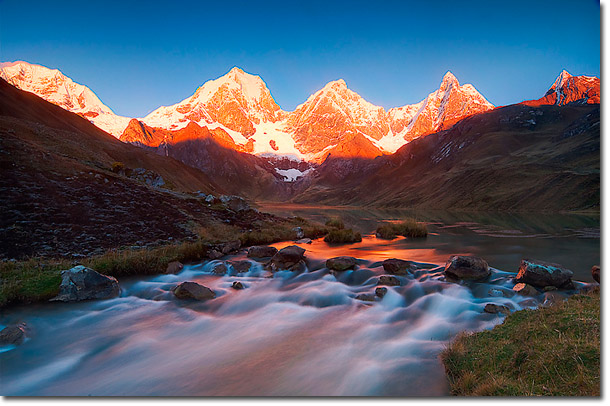
Awakening
The image “Awakening” was pre-visualized based on such knowledge. I knew that an image was possible with these peaks in the background, the lake in the middle ground, complete with a rushing stream in the foreground, capturing the key characteristics of this breathtaking landscape. It was pure magic when I found the spot – as if I visited it in a past life (if there is such a thing) and then re-discovered it.
Familiarity
Research alone will not be enough when you are trying to go beyond obvious and pretty pictures. The image “Cloud motion over Jirishanca” is a good example. After spending a few nights under this peak, I finally saw this image. It’s a mid-afternoon shot with a 10-stop ND filter to capture the ferocity of wind that batters the summits of these high peaks during that time of the day. Once you spend plenty of time at one location, you will start to see more interesting and unusual images.
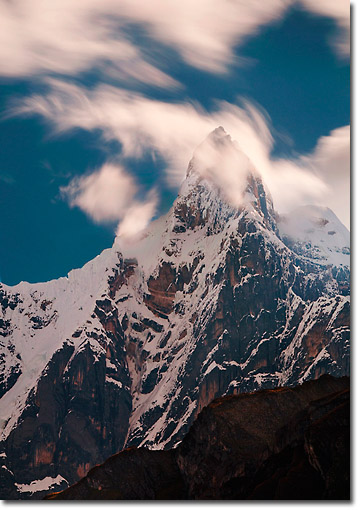
Cloud motion over Jirishanca
To become familiar with a place, photographers must do more than just spend quality time there. Participating in some outdoor activity, such as hiking to a high point, exploring the forests, or paddling a river, will teach so much about the place. Interacting with local people and learning about their culture and way of life can do the same. We often try to ignore all the traces of human civilization in our shots, but in many parts of the world, human beings are just an inseparable part of the landscape. For example, “Mountain boy” packs so much story for me in one picture that many pretty, golden hour landscape shots together will not compare to. In these high Andes regions of Peru, local people have been living in very remote areas (sometimes 3-4 days walking distance from any paved road) for generations. This boy in the image lives in such a location with his parents and two incredible sweet little sisters, and hike up and down the mountains everyday with his herd of sheep. I spent a lot time talking with the family overcoming the steep language barrier and took this image one morning when he was looking out for his dog. The weather battered face of the boy sums of the incredible hardness and simple innocence of these people living in the shadow of those great peaks.
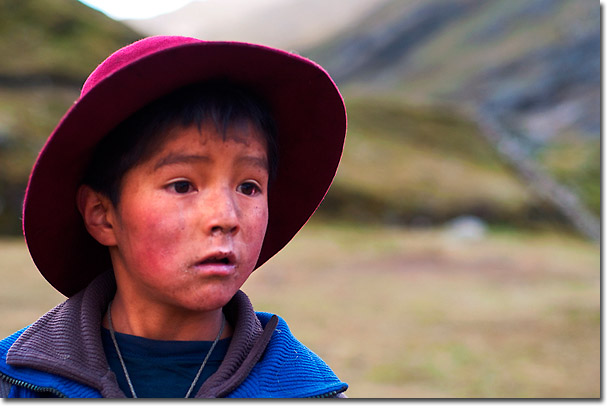
Mountain Boy
Fascination
Facts and familiarity breed a connection, but until you are truly fascinated about a place, you will not be able to truly connect with the spirit of that location. We don’t become fascinated by all the places that we visit, but some places hypnotize us by their magic and we keep going back over and over to enjoy them. This place may be Yosemite for some, or just your local state park or forest that captures your imagination. I live in the lower Hudson valley in New York, and one such place for me is the Taconic range that lies in the borders of 3 states, New York, Connecticut, and Massachusetts. Some of the oldest mountains on the continent, this range is also home of miles of very diverse contiguous forest, remote trails, and wild summits. I have been hiking this range for years, but never came back with “keeper” photos. Only this year, during my last few visits, was I able to capture some images that captured my imagination. My fascination with this area will keep me coming back. Hopefully, I will be able to build the sufficient connection to truly capture the wild spirit of the range. "Taconic Evening" and "Ravine Falls" are two example of my recent images from the area.
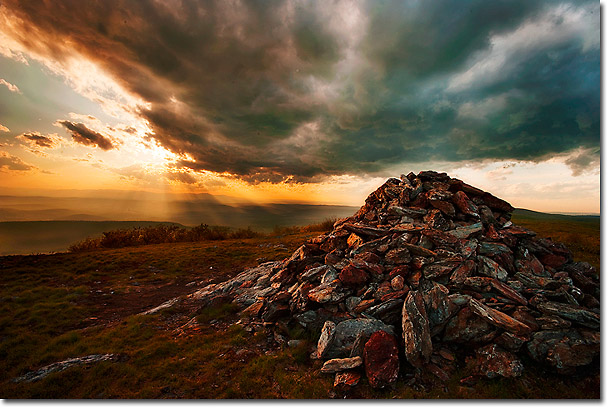
Taconic Range
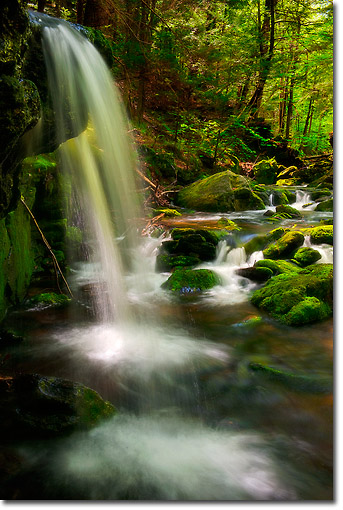
Ravine Falls
Most of Ansel Adam’s best works came from Yosemite while most of Galen Rowel’s best works come from Sierra Nevada and the Himalayas. Not surprisingly, these are the places that these masters adored and had deep connections with. The more we are able to form connections with nature, the more she reveals her true beauty and character to us. Take your time to build these connections and you will never regret it. The truth that all genres of photography share is connection between the artist and the subject which forms the soul of the image.
Comments on NPN nature photography articles? Send them to the editor. NPN members may also log in and leave their comments below.
Arnab Banerjee lives in the lower Hudson Valley of New York. His love of photography and nature is a long time affair and has evolved through many of the mountaineering and exploration trips to the high mountain ranges and wildernesses across the world. By profession, he is a business strategist and he spends the rest of his time making evocative and unique nature images. His writing and images have been published in many journals. More of his work can be seen at his website, http://www.arnabbanerjee.com.